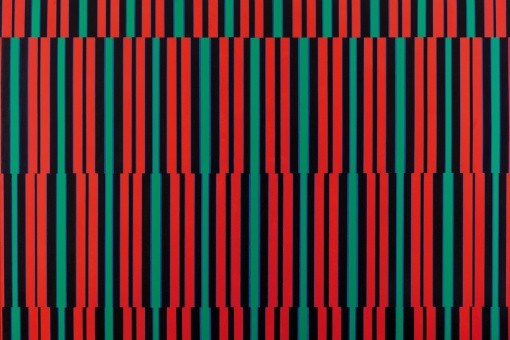Günter Fruhtrunk
25 May - 02 Sep 2012
GÜNTER FRUHTRUNK
Paint Rhythm Existence
25 May – 2 September 2012
Günter Fruhtrunk (1923–1982) was one of the few German artists who not only continued to work in the aesthetic tradition of Classical Modernism after 1945, but who actually embraced its ideals and values, and sought to apply them to the new social order.
In 1963, having spent a long time in Paris, Fruhtrunk achieved his breakthrough with an exhibition at the Museum am Ostwall in Dortmund. For many years, he was one of the most talkedabout artists in Germany. Yet after his early death, his name was increasingly forgotten.
In retrospect, Fruhtrunk’s abstract geometric, non-figurative painting, coupled with his social and political engagement, distinguish him as one of the most enduring and inspirational figures in postwar German art. Rekindling public awareness of this artist’s pivotal role is one of the main aims of this exhibition.
The exquisite painterly sensitivity and quality of his oeuvre go hand in hand with an earnest endeavour to address the issues of the modern age and contribute to the ideal of individual self-determination.
In pursuit of this, Fruhtrunk developed a singular system of painting that articulates the quest for enlightenment by activating a way of seeing that involves confronting fundamental existential questions.
While this exhibition charts his career in broadly chronological order, it also includes a section devoted to the previously unacknowledged influence of music on Fruhtrunk’s work. In addition, some small studies he evidently made to explore the use of different carriers, and how different techniques affect the behaviour of paint can be seen for the first time.
The exhibition is a Kunstmuseum Liechtenstein production, curated by Friedemann Malsch.
Paint Rhythm Existence
25 May – 2 September 2012
Günter Fruhtrunk (1923–1982) was one of the few German artists who not only continued to work in the aesthetic tradition of Classical Modernism after 1945, but who actually embraced its ideals and values, and sought to apply them to the new social order.
In 1963, having spent a long time in Paris, Fruhtrunk achieved his breakthrough with an exhibition at the Museum am Ostwall in Dortmund. For many years, he was one of the most talkedabout artists in Germany. Yet after his early death, his name was increasingly forgotten.
In retrospect, Fruhtrunk’s abstract geometric, non-figurative painting, coupled with his social and political engagement, distinguish him as one of the most enduring and inspirational figures in postwar German art. Rekindling public awareness of this artist’s pivotal role is one of the main aims of this exhibition.
The exquisite painterly sensitivity and quality of his oeuvre go hand in hand with an earnest endeavour to address the issues of the modern age and contribute to the ideal of individual self-determination.
In pursuit of this, Fruhtrunk developed a singular system of painting that articulates the quest for enlightenment by activating a way of seeing that involves confronting fundamental existential questions.
While this exhibition charts his career in broadly chronological order, it also includes a section devoted to the previously unacknowledged influence of music on Fruhtrunk’s work. In addition, some small studies he evidently made to explore the use of different carriers, and how different techniques affect the behaviour of paint can be seen for the first time.
The exhibition is a Kunstmuseum Liechtenstein production, curated by Friedemann Malsch.

